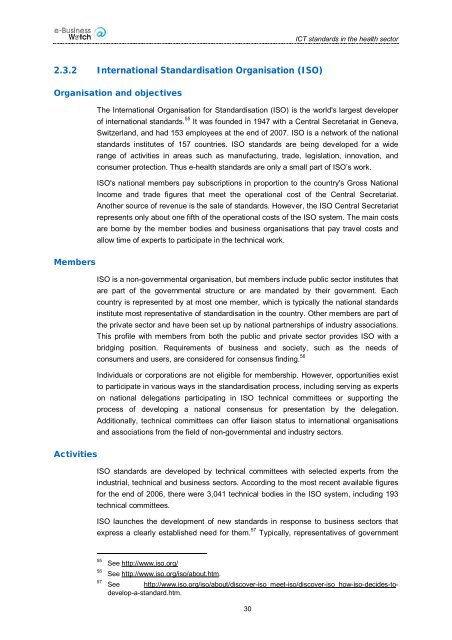<strong>ICT</strong> <strong>st<strong>and</strong>ards</strong> <strong>in</strong> <strong>the</strong> <strong>health</strong> <strong>sector</strong>2.3.2 International St<strong>and</strong>ardisation Organisation (ISO)Organisation <strong>and</strong> objectivesMembersActivitiesThe International Organisation for St<strong>and</strong>ardisation (ISO) is <strong>the</strong> world's largest developerof <strong>in</strong>ternational <strong>st<strong>and</strong>ards</strong>. 55 It was founded <strong>in</strong> 1947 with a Central Secretariat <strong>in</strong> Geneva,Switzerl<strong>and</strong>, <strong>and</strong> had 153 employees at <strong>the</strong> end of 2007. ISO is a network of <strong>the</strong> national<strong>st<strong>and</strong>ards</strong> <strong>in</strong>stitutes of 157 countries. ISO <strong>st<strong>and</strong>ards</strong> are be<strong>in</strong>g developed for a widerange of activities <strong>in</strong> areas such as manufactur<strong>in</strong>g, trade, legislation, <strong>in</strong>novation, <strong>and</strong>consumer protection. Thus e-<strong>health</strong> <strong>st<strong>and</strong>ards</strong> are only a small part of ISO’s work.ISO's national members pay subscriptions <strong>in</strong> proportion to <strong>the</strong> country's Gross NationalIncome <strong>and</strong> trade figures that meet <strong>the</strong> operational cost of <strong>the</strong> Central Secretariat.Ano<strong>the</strong>r source of revenue is <strong>the</strong> sale of <strong>st<strong>and</strong>ards</strong>. However, <strong>the</strong> ISO Central Secretariatrepresents only about one fifth of <strong>the</strong> operational costs of <strong>the</strong> ISO system. The ma<strong>in</strong> costsare borne by <strong>the</strong> member bodies <strong>and</strong> bus<strong>in</strong>ess organisations that pay travel costs <strong>and</strong>allow time of experts to participate <strong>in</strong> <strong>the</strong> technical work.ISO is a non-governmental organisation, but members <strong>in</strong>clude public <strong>sector</strong> <strong>in</strong>stitutes thatare part of <strong>the</strong> governmental structure or are m<strong>and</strong>ated by <strong>the</strong>ir government. Eachcountry is represented by at most one member, which is typically <strong>the</strong> national <strong>st<strong>and</strong>ards</strong><strong>in</strong>stitute most representative of st<strong>and</strong>ardisation <strong>in</strong> <strong>the</strong> country. O<strong>the</strong>r members are part of<strong>the</strong> private <strong>sector</strong> <strong>and</strong> have been set up by national partnerships of <strong>in</strong>dustry associations.This profile with members from both <strong>the</strong> public <strong>and</strong> private <strong>sector</strong> provides ISO with abridg<strong>in</strong>g position. Requirements of bus<strong>in</strong>ess <strong>and</strong> society, such as <strong>the</strong> needs ofconsumers <strong>and</strong> users, are considered for consensus f<strong>in</strong>d<strong>in</strong>g. 56Individuals or corporations are not eligible for membership. However, opportunities existto participate <strong>in</strong> various ways <strong>in</strong> <strong>the</strong> st<strong>and</strong>ardisation process, <strong>in</strong>clud<strong>in</strong>g serv<strong>in</strong>g as expertson national delegations participat<strong>in</strong>g <strong>in</strong> ISO technical committees or support<strong>in</strong>g <strong>the</strong>process of develop<strong>in</strong>g a national consensus for presentation by <strong>the</strong> delegation.Additionally, technical committees can offer liaison status to <strong>in</strong>ternational organisations<strong>and</strong> associations from <strong>the</strong> field of non-governmental <strong>and</strong> <strong>in</strong>dustry <strong>sector</strong>s.ISO <strong>st<strong>and</strong>ards</strong> are developed by technical committees with selected experts from <strong>the</strong><strong>in</strong>dustrial, technical <strong>and</strong> bus<strong>in</strong>ess <strong>sector</strong>s. Accord<strong>in</strong>g to <strong>the</strong> most recent available figuresfor <strong>the</strong> end of 2006, <strong>the</strong>re were 3,041 technical bodies <strong>in</strong> <strong>the</strong> ISO system, <strong>in</strong>clud<strong>in</strong>g 193technical committees.ISO launches <strong>the</strong> development of new <strong>st<strong>and</strong>ards</strong> <strong>in</strong> response to bus<strong>in</strong>ess <strong>sector</strong>s thatexpress a clearly established need for <strong>the</strong>m. 57 Typically, representatives of government555657See http://www.iso.org/See http://www.iso.org/iso/about.htm.See http://www.iso.org/iso/about/discover-iso_meet-iso/discover-iso_how-iso-decides-todevelop-a-st<strong>and</strong>ard.htm.30
<strong>ICT</strong> <strong>st<strong>and</strong>ards</strong> <strong>in</strong> <strong>the</strong> <strong>health</strong> <strong>sector</strong>agencies, test<strong>in</strong>g laboratories, consumer associations, non-governmental organisationsas well as academic circles jo<strong>in</strong> <strong>the</strong> process to also represent <strong>the</strong> views <strong>and</strong> needs ofo<strong>the</strong>r stakeholders. National delegations of experts of a technical committee meet todiscuss, debate <strong>and</strong> argue until <strong>the</strong>y reach consensus on a draft agreement. This iscirculated as a Draft International St<strong>and</strong>ard to ISO’s members for comment <strong>and</strong> ballot<strong>in</strong>g.If <strong>the</strong> vot<strong>in</strong>g is <strong>in</strong> favour, <strong>the</strong> document, with eventual modifications, is circulated to <strong>the</strong>members as a F<strong>in</strong>al Draft International St<strong>and</strong>ard. If that vote is positive, <strong>the</strong> document is<strong>the</strong>n published as an International St<strong>and</strong>ard. One of ISO’s pr<strong>in</strong>ciples is that it does notpublish a st<strong>and</strong>ard that conflicts with any st<strong>and</strong>ard that ISO published before. ISO thussupports <strong>st<strong>and</strong>ards</strong> harmonisation.In <strong>the</strong> field of e-<strong>health</strong>, ISO is actively <strong>in</strong>volved <strong>in</strong> <strong>the</strong> st<strong>and</strong>ardisation of <strong>health</strong> <strong>ICT</strong> toachieve compatibility <strong>and</strong> <strong>in</strong>teroperability between <strong>in</strong>dependent systems. The relatedTechnical Committee is TC 215 “<strong>health</strong> <strong>in</strong>formatics”. 58 TC 215 <strong>current</strong>ly has n<strong>in</strong>e work<strong>in</strong>ggroups for which <strong>the</strong> follow<strong>in</strong>g six are most relevant for this report: 59 WG 1 Data structure,WG 2 Data <strong>in</strong>terchange, WG 3 Semantic content, WG 5 Health cards, WG 8 Bus<strong>in</strong>essrequirements for Electronic Health Records, WG 9 Harmonisation. 60 By <strong>the</strong> end of 2007,ISO TC 215 had published 44 <strong>st<strong>and</strong>ards</strong>, <strong>and</strong> 36 <strong>st<strong>and</strong>ards</strong> were under development.Among <strong>the</strong> most important published ones for this report is ISO/TR 18307:2001,“Interoperability <strong>and</strong> compatibility <strong>in</strong> messag<strong>in</strong>g <strong>and</strong> communication <strong>st<strong>and</strong>ards</strong>”. Animportant part of ISO’s work is <strong>the</strong> fur<strong>the</strong>r development <strong>and</strong> world-wide approval of<strong>st<strong>and</strong>ards</strong> that have orig<strong>in</strong>ally been developed by o<strong>the</strong>r SDOs. For example, ISOst<strong>and</strong>ard 12052:2006 is a DICOM st<strong>and</strong>ard, <strong>and</strong> ISO <strong>current</strong>ly fur<strong>the</strong>r develops EHR<strong>st<strong>and</strong>ards</strong> that were <strong>in</strong> first <strong>in</strong>stance developed by CEN.AssessmentIn <strong>the</strong> SeBW e-<strong>health</strong> expert survey, a very large share of <strong>the</strong> respondents, 84%, agreedthat ISO TC 215 should be important <strong>in</strong> <strong>the</strong> future. This very positive assessment may bedue to ISO’s position as <strong>the</strong> world’s largest developer of <strong>in</strong>ternational <strong>st<strong>and</strong>ards</strong> <strong>and</strong> asupposed need for <strong>in</strong>ternational <strong>st<strong>and</strong>ards</strong> <strong>in</strong> <strong>the</strong> field of e-<strong>health</strong>. It may also be due toISO’s bridg<strong>in</strong>g position between <strong>the</strong> public <strong>and</strong> <strong>the</strong> private <strong>sector</strong>. ISO also took a position<strong>in</strong> harmonis<strong>in</strong>g e-<strong>health</strong> <strong>st<strong>and</strong>ards</strong> by becom<strong>in</strong>g <strong>in</strong>volved <strong>in</strong> a co-operation <strong>in</strong>itiative withCEN <strong>and</strong> HL7 <strong>in</strong> 2007.In <strong>the</strong> expert <strong>in</strong>terviews <strong>and</strong> o<strong>the</strong>r statements received for this report, positiveassessments about ISO <strong>in</strong>cluded that it is a powerful organisation <strong>and</strong> that its <strong>st<strong>and</strong>ards</strong>are technically well elaborated. Weaknesses that were mentioned <strong>in</strong>cluded that ISO<strong>st<strong>and</strong>ards</strong> are developed ma<strong>in</strong>ly by academics <strong>and</strong> that <strong>the</strong> documentations are toosophisticated for <strong>the</strong> market. ISO <strong>st<strong>and</strong>ards</strong> lack market adoption because <strong>the</strong>re is<strong>in</strong>sufficient implementation support. ISO works “too much detached from reality” <strong>and</strong>would benefit from more <strong>in</strong>volvement from users.585960Seehttp://www.iso.org/iso/<strong>st<strong>and</strong>ards</strong>_development/technical_committees/list_of_iso_technical_committees/iso_technical_committee.htm?commid=54960.The o<strong>the</strong>r work<strong>in</strong>g groups are WG 4 Security, WG 6 Pharmacy <strong>and</strong> medic<strong>in</strong>es bus<strong>in</strong>ess, <strong>and</strong>WG 7 Devices.WG 9 is a recent implementation <strong>and</strong> not listed on ISO’s website at <strong>the</strong> time of writ<strong>in</strong>g thisreport.31
















